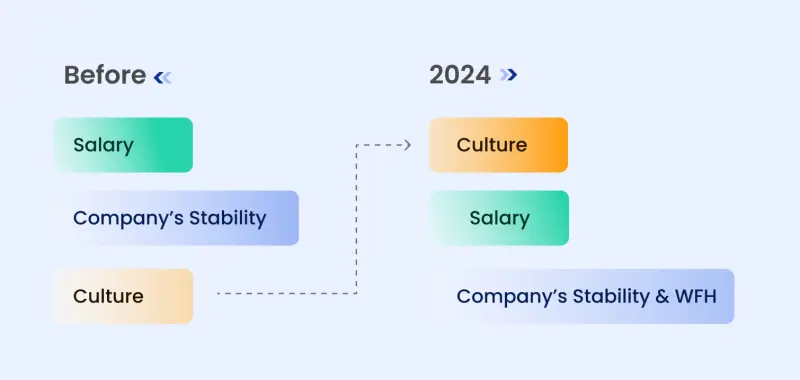10 Technology Hiring Trends to Gain Competitive Edge in 2025
- TECHVIFY Team
- 0 Comments
The technology sector is advancing at an unprecedented pace, and the HR landscape is evolving right alongside it. To attract top talent, HR professionals and organizations need to stay ahead of emerging technology hiring trends. This year, we are witnessing significant shifts in hiring practices that will redefine our understanding of the future workforce.
According to a Microsoft study, the number of technology jobs worldwide is expected to skyrocket from 41 million in 2020 to an incredible 190 million by 2025. This highlights the tremendous growth and opportunities within the tech industry. This blog aims to equip HR leaders and talent acquisition professionals with key insights into the top tech hiring trends for 2024. Let’s explore the essential technology hiring trends that every HR and TA professional should be aware of.
I. The Technology Hiring Trends Recruiters Should Expect This Year and 2025
1. Embrace Remote and Flexible Work
Tech organizations are increasingly adopting remote and flexible work environments following the changes brought about by the COVID-19 pandemic. Robert Half’s remote work statistics show that 87% of job seekers prefer fully remote or hybrid roles due to these options’ flexibility and work-life balance. This shift benefits both employees and organizations, as it expands the talent pool to include geographically diverse candidates.
Shift in Tech Hiring Trends
2. Focus on Candidate Experience
In a competitive job market, prioritizing candidate experience is crucial for attracting and retaining top talent. A smooth and transparent interview process leaves a positive impression on the employer’s brand. By enhancing candidate experience, organizations demonstrate their respect for candidates’ time and effort during recruitment.
Companies can improve the candidate journey by creating a seamless and personalized experience. Effective communication is essential, keeping candidates informed and engaged throughout the hiring process. This includes timely responses to inquiries, clear instructions for the next steps, and constructive feedback after interviews. Streamlining the process to eliminate unnecessary steps and using user-friendly application portals can significantly enhance the candidate experience.
Adopting these strategies will set your organization apart as a preferred employer, attracting top talent and fostering long-term relationships, even with candidates who were not initially successful.
3. Utilize Data and AI in Recruitment
The integration of Data Analytics and Artificial Intelligence (AI) is transforming talent acquisition by streamlining the recruitment process from sourcing to candidate assessment. Data-driven solutions enable HR professionals to make informed decisions based on comprehensive information, enhancing the efficiency and effectiveness of hiring.
According to an IBM survey, 30% of global IT professionals report significant time savings with new automation software and tools. AI tools use algorithms to predict job fit and evaluate candidates, saving time and resources compared to traditional screening methods.
Additionally, virtual assistants and AI-powered chatbots are becoming valuable investments for candidate engagement and interaction throughout the recruitment process.
4. Increasing Importance of Soft Skills
Technical skills alone are no longer sufficient; soft skills are becoming increasingly crucial in the IT sector. The demand for soft skills such as teamwork, employee motivation, and effective relationship-building underscores the industry’s shift toward tech-driven initiatives across all business areas.
A LinkedIn survey found that 92% of respondents value soft skills more than technical skills, and 89% noted that poor hires often lack these essential soft skills. This highlights the importance of soft skills in talent acquisition and organizational success in the IT industry.
Recruiters are now focusing on candidates with key soft skills necessary for growth in the industry:
-
- Effective Communication: With the complexity of technological concepts, there is a growing need for employees who can simplify these ideas and communicate them clearly to both internal and external stakeholders.
- Problem-Solving Attitude: The IT industry thrives on overcoming challenges through innovative technology implementation. Employers are seeking individuals who are creative and can provide imaginative solutions.
- Adaptability: The ability to adjust to rapid technological advancements is crucial. Candidates who demonstrate flexibility and resilience during times of change are valuable assets to organizations aiming for long-term success.
Looking to outsource your service? Read these articles first:
5. Integrate Gig Economy Workers
The gig economy is reshaping technology hiring processes, with organizations increasingly relying on contract and freelance workers who provide specialized skills and expertise. This approach offers flexibility and scalability to meet project needs.
Incorporating gig workers into traditional company settings has several benefits, including access to a diverse talent pool, cost-effectiveness, and adaptability to market changes. Gig workers also enjoy the freedom to choose their working style, projects, and duration, leading to better work-life balance and job satisfaction. Successful integration of gig workers requires careful management and collaboration to achieve desired outcomes.
Companies can drive innovation and effectively meet business objectives by leveraging traditional and gig workers.
6. Growing Demand for Cybersecurity Talent
Cyberattacks expose digital networks to unauthorized access, risking data, financial loss, and consumer trust. As digital data production increases, the frequency of cyberattacks is expected to rise. Therefore, it is crucial to have skilled cybersecurity talent to protect organizational data and systems.
Organizations need experts in cybersecurity to safeguard against these threats and ensure data integrity and security.
7. Welcoming Back Boomerang Employees
In 2024, companies are focusing on maintaining good relationships with retired employees, creating opportunities for future collaboration. Significant investments in new technologies help maintain workforce performance and allow talent acquisition teams to track former employees.
Organizations recognize the value of building and maintaining these relationships, using this strategy to navigate economic challenges and maintain a competitive edge.
8. Enhance Employee Skills and Career Growth
Modern workplaces often lack the infrastructure and support systems necessary to keep employees’ skills up-to-date. This deficiency threatens innovation and retention, with three-quarters of millennial and Gen Z workers indicating they might leave their jobs next year due to a lack of skill development opportunities.
Upskilling can help companies meet operational demands while engaging employees. Structured training programs equip workers with new skills, helping the organization stay competitive and adhere to best practices. For example, PwC has committed $3 billion to its “New World, New Skills” program, providing digital skills training to all 276,000 employees and incentivizing the creation of digital tools and time-saving processes. Similarly, Lincoln Financial offers its actuarial employees training in emerging trends like big data and predictive analytics.
Have a Project Idea in Mind?
Get in touch with experts for a free consultation. We’ll help you decide on next steps, explain how the development process is organized, and provide you with a free project estimate.
9. Declining Emphasis on College Degrees
Breaking into the tech field no longer necessarily requires an engineering degree. Employers are increasingly moving away from requiring four-year degrees for job seekers. The number of recruiters hiring tech talent with non-academic backgrounds doubled between 2021 and 2022.
This trend aligns with the broader workforce sentiment, as student debt continues to climb and public opinion shifts away from higher education as the ultimate success marker. A Gallup poll of 2,000 Americans revealed that only half view a college degree as “very important.”
Employers can broaden their talent pool and foster more diverse teams by reducing the emphasis on traditional degrees and focusing on skills-based hiring.
10. Offer Competitive Compensation and Benefit Packages
In the competitive tech talent acquisition landscape, attractive remuneration and benefits are crucial for recruiting and retaining top talent. Studies consistently show that monetary benefits and perks are among the top factors individuals consider when looking for work and evaluating potential employers.
Organizations are exploring compensation trends to stay competitive. Equity-based remuneration is becoming increasingly popular, especially among high-growth tech companies and startups. This approach aligns employees’ interests with the organization’s long-term goals.
II. How do Companies Adapt to the Changing Tech Hiring Trends?
As straightforward as it may sound, attracting top IT talent is a significant challenge. These professionals are often elusive on the job market, making them difficult to spot and even harder to attract. So, where do companies find these top talents?
According to a Coderpad survey of 5,500 recruiters from 143 countries, many companies are looking abroad for tech talent. In 2022, 40% of recruiters reported hiring internationally, and this number has increased to 51% in 2024.
Leveraging International Talent
The growing recruitment tech hiring trends internationally allow companies to tap into a broader and more diverse talent pool. By expanding their search beyond local markets, organizations can find highly skilled professionals who might not be available domestically.
Recruitment Technology Trends
Utilizing Recruitment Sites
Recruitment sites are rapidly gaining importance as a primary tool for sourcing international talent. According to another survey, both employers and job seekers are increasingly relying on these platforms over company pages and employee referrals. The MIT Sloan Review’s “Hiring Trends in 2024” indicates that:
-
-
- 58% of hiring decision-makers use recruitment sites as their top source for finding qualified talent.
- 48% of job seekers conduct in-depth research into new opportunities through these sites.
-
Recruitment sites offer several advantages:
-
-
- Broader Reach: These platforms connect employers with a vast pool of candidates from around the world.
- Efficiency: Advanced search algorithms and filtering options make identifying candidates with the specific skills and qualifications easier.
- Cost-Effectiveness: Compared to traditional hiring methods, recruitment sites can be more economical, reducing the time and resources spent on the hiring process.
-
III. In-Demand Positions in Software Development
With the ever-growing need for software engineers, Coderpad’s 2024 survey sheds light on the most sought-after competencies in the field. Here are some key insights into the positions that are currently in high demand:
Full-Stack Developers/Engineers
Full-stack developers are highly sought after because they can handle both front-end and back-end development. Their versatility makes them invaluable to companies looking to build comprehensive and cohesive applications.
Back-End Developers/Engineers
Back-end developers continue to be in high demand as they are essential for building and maintaining the server-side logic, databases, and application architecture. This role is critical for ensuring the performance, scalability, and security of applications.
AI/Machine Learning Specialists
The demand for AI and machine learning specialists is on the rise. These professionals are crucial for developing emerging technologies and implementing intelligent systems that can learn and adapt.
Technology hiring trends
Mid-Level and Junior Developers
There is a notable increase in demand for mid-level and junior developers. This trend may be attributed to several factors:
-
-
- Fewer Open Senior Positions: Many senior positions might already be filled.
- Budget Constraints: Hiring less experienced developers can help manage costs.
- Evolving Complexity: As some aspects of technology become more streamlined, there may be less need for high levels of seniority.
-
IV. Challenges in Recruiting Tech Talent and How to Solve Them in 2025
Despite the impact of layoffs on the job market, organizations continue to face significant challenges in hiring qualified tech talent. Here are some of the key issues and potential solutions:
| Challenge | Description | Solution |
|---|---|---|
| High Cost of Tech Talent | Tech salaries have surged, with some key roles seeing a 20% increase from 2020–2022. Smaller organizations often find themselves outbid by tech giants. |
– Expand Search: Open up to remote talent to access a wider, potentially more affordable pool. – Streamline Recruitment: Optimize processes to reduce inefficiencies and cost-per-hire. – Cost-Effective Hiring Practices: Use alumni networks, talent pools, and referral schemes to lower CPH without reducing salaries. |
| Prolonged Hiring Processes | Slow, inefficient hiring processes can result in losing top candidates to competitors. Open positions also cost money and delay operations. |
– Process Optimization: Review each step in the hiring process for efficiency. – Pre-Build Candidate Pipelines: Prepare ahead of time to contact candidates when roles open quickly. – Utilize Automation: To save time, implement applicant tracking systems (ATS). |
| Difficulty in Sourcing Quality or Niche Talent | Simply posting job descriptions isn’t enough. Companies must be proactive and creative in their recruitment efforts. |
– Engage Passive Candidates: Reach out to candidates who aren’t actively searching for jobs. – Tap Non-Traditional Paths: Consider STEM graduates and coding bootcamps. – Widen Search Radius: Use tools like LinkedIn Recruiter to search beyond local areas. – Leverage Offline Methods: Attend job fairs, conferences, and industry events, or host your own. |
Conclusion
The tech industry is experiencing significant changes, with an expected increase in job openings and a more stable recruitment environment in 2024. Key technology hiring trends to watch include the rise of remote work, the emphasis on candidate experience, the integration of AI in recruitment, and the importance of soft skills. Organizations can attract and retain top tech talent by adapting to these trends.
For top-tier outsourcing services that can help you overcome these recruitment challenges and access the best tech talent, contact TECHVIFY. Our expertise in the tech industry ensures you get the right skills and solutions tailored to your needs. Reach out to us today to learn how we can support your hiring goals and drive your business forward.
TECHVIFY – Global AI & Software Solution Company
From Startups to Industry Leaders: TECHVIFY prioritizes results, not just deliverables. Accelerate your time to market and see ROI early with high-performing teams, AI (including GenAI) Software Solutions, and ODC (Offshore Development Center) services.
- Email: contact@techvify.com.vn
- Phone: (+84)24.77762.666








